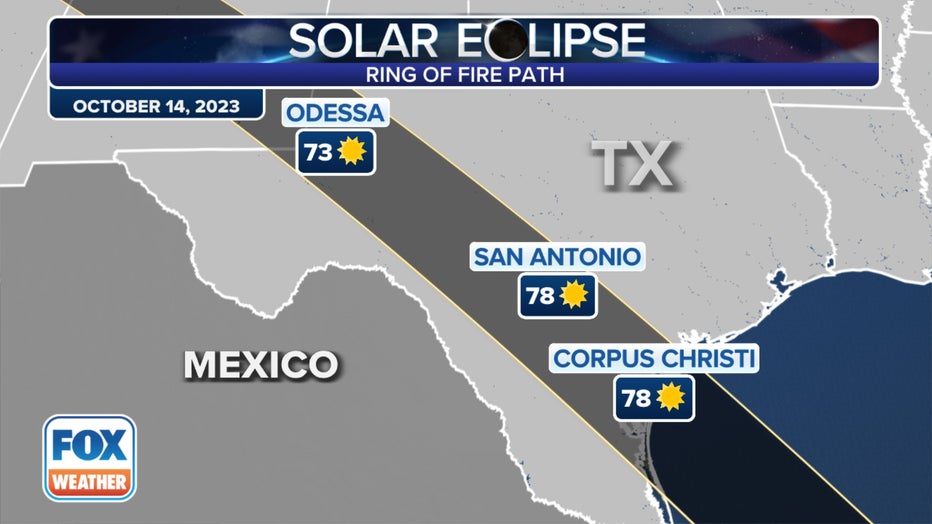Solar eclipse forecast: Southwest likely to have best viewing conditions for October 'ring of fire'

How to make a solar eclipse viewing box
For those who can't get their hands on a pair of eclipse glasses, there is an alternative to the fancy specs: a DIY projection box.
Millions of people from Texas to Oregon will be hoping for a cloudless sky to witness the "ring of fire" created during an annular solar eclipse Oct. 14, with a swath of the western U.S. along the 125-mile-wide path of maximum eclipse.
On the morning of Oct. 14, the Moon will pass in front of the Sun, eclipsing nearly 90% of it. This is known as an annular solar eclipse because the Moon is at the farthest point in its orbit of Earth. During the maximum eclipse, known as annularity, the light from the Sun around the Moon, creates the "ring of fire" for which the annular eclipse is known. For places not along the path of annularity, a partial eclipse will be visible.
With an annular solar eclipse, you need to wear solar eclipse glasses during the entire event to look at the Sun. At no point is it safe to take off your glasses to watch an annular solar eclipse.
To view this eclipse, you'll need your solar eclipse glasses and a clear view of a mostly cloudless sky.
Here's a look at the forecast along the entire eclipse path, which stretches from the Pacific Northwest to the Southwest to the Texas Gulf Coast.

The cloud cover forecast along the entire solar eclipse path from Oregon to Texas on Oct. 14, 2023.(FOX Weather)
The eclipse in the U.S. begins in Oregon just after 8 a.m. PDT and the partial eclipse ends in southeastern Texas at 1:33 p.m. CDT.
Utah, New Mexico and Texas may have the best view of the "ring of fire" on Oct. 14, with little to no cloud cover and moderate fall temperatures in the forecast.
Pro-tip: Use the FOX Weather app's planning tool to see the forecast for where you plan to view the solar eclipse.
Stay with FOX Weather for updated forecasts leading up to the solar eclipse.

(FOX Weather)
Oregon, California and Idaho eclipse forecast
Fog could be a concern for those in Oregon early in the day. Heading to a higher elevation may give you a better chance to see the "ring of fire" with your eclipse glasses.
WHERE TO SEE THE 'RING OF FIRE' IN CALIFORNIA DURING THE ANNULAR SOLAR ECLIPSE
Expect chilly viewing conditions in Northern California on the morning of the solar eclipse with partial cloud cover.
Just the southwest sliver of Idaho is within the 125-mile-wide path of the annular solar eclipse.

The forecast on Oct. 14 along the solar eclipse path in Oregon and California.(FOX Weather)
Nevada eclipse forecast
Temperatures in the low 70s will make for pleasant viewing in Nevada during annularity but clouds may be around to interfere with prime viewing conditions.

The forecast on Oct. 14 along the solar eclipse path in Nevada.(FOX Weather)
Utah eclipse forecast
The swath of the annular solar eclipse includes Canyonlands National Park, and two more popular national parks are just outside the "ring of fire."
Expect moderate temperatures in the low 70s with a few clouds. Unfortunately, areas such as Richfield may experience significant cloud cover.

The forecast on Oct. 14 along the solar eclipse path in Utah.(FOX Weather)
Arizona and Colorado eclipse forecast
The eclipse will pass through the Four Corners, where Utah, Colorado, New Mexico and Arizona meet.
The forecast for the area calls for increasing sunshine as you head south and east with temperatures in the upper 60s and low 70s.
WHERE TO SEE 'RING OF FIRE' IN COLORADO DURING OCTOBER ANNULAR ECLIPSE

The forecast on Oct. 14 along the solar eclipse path straddling between Arizona and Colorado.(FOX Weather)
New Mexico eclipse forecast
New Mexico is expected to be a hot spot for eclipse viewers because of the good weather for October and the Albuquerque International Balloon Fiesta.
Temperatures will be pleasant in the upper 70s and low 80s with mostly sunny skies, including Albuquerque, with just a few clouds around.

The forecast on Oct. 14 along the solar eclipse path in New Mexico.(FOX Weather)
Texas eclipse forecast
The final stretch of the solar eclipse will be in the Lone Star State from the Texas Panhandle to the Gulf of Mexico.
The FOX Model shows little to no cloud cover over most of Texas for the eclipse, which could provide an excellent eclipse viewing experience for skygazers.
In Corpus Christi, the temperature will be warm, with a high in the upper 80s by the afternoon. In West Texas, temperatures will be more moderate, with a high forecast of about 80 degrees.

The forecast on Oct. 14 along the solar eclipse path in Texas.(FOX Weather)

